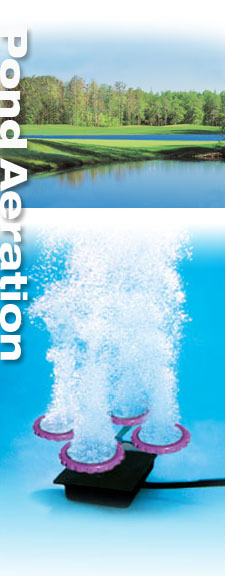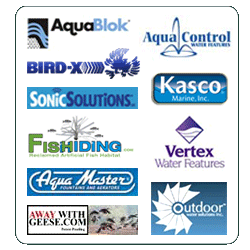Home > Products and Services > Aeration Systems
Pond Aeration

What is pond aeration?
Pond aeration is defined as adding air to water for the purpose of increasing oxygen levels and improving circulation. The most effective and practical management tool used to maintain and improve water quality is a pond aeration system. There are several types of pond aeration systems, but the most efficient is the Vertex pond aeration system.
Air is delivered from a piston compressor located in a shore mounted QuietAirT cabinet though BottomLineT self weighted air supply tubing to an AirStationT on the bottom of the pond. Because of the unique design of Vertex AirStations, millions of .5mm bubbles rise and entrain up to 8,000 gallons of water per minute from the pond bottom to the surface influencing the entire water column and exposing it to the surface where harmful gases are expelled and oxygen is absorbed. A pond aeration system brings oxygen into the water, eliminates stratification and increases circulation.
Why aerate a pond?
Pond aeration ensures the characteristics of a healthy lake: 1) Sufficient oxygen and 2) adequate mixing of the water to reduce stratification so that the oxygen is uniformly distributed throughout the water column. Fish, vegetation and beneficial microorganisms depend on dissolved oxygen for respiration.
Pond aeration allows the water at all depths the ability to support animal and plant life, control algae growth by limiting its food source and aid decomposition of suspended organic material and muck on the bottom of the lake. Through circulation, the water is able to release harmful gases that build up on the bottom into the atmosphere, thereby further improving water quality and eliminating any unpleasant odors. A pond aeration system improves the aesthetics and overall health of a body of water.
When to aerate?
A pond aeration system can be beneficial all year long. In the summer, hot, cloudy and still weather can lead to oxygen depletion. Warm water holds much less oxygen than cold water, and cloud cover further limits available sunlight, which slows down photosynthesis. Wind speeds and duration are typically less in the summer, which also reduces water circulation and surface oxygen diffusion. Warmer water temperatures cause an increase in fish activity and metabolism and raises the demand for oxygen.
Without pond aeration, stratification will likely occur - resulting in little or no oxygen in the deeper water (hypolimnion). A sudden rainfall can cause the upper, oxygen rich layer (epilimnion) to cool and mix with the hypolimnion where the oxygen is quickly consumed, resulting in a large-scale fish kill. A pond aeration system can prevent a summer fish kill.
In the winter, a fish kill can occur as a result of a decline in oxygen during a long period of ice cover. A pond aeration system can keep selected areas free of ice where surface diffusion will ensure sufficient oxygen levels.
How to determine what size aeration system?
There are many factors that make each pond unique. Size, depth, slope, shape, and nutrient load should all be taken into consideration when designing a pond aeration system. Vertex pond aeration systems have been independently tested to determine how many gallons per minute each AirStation can lift from the bottom of a pond to the surface at a particular depth based on the amount of airflow.
DISTRIBUTOR




